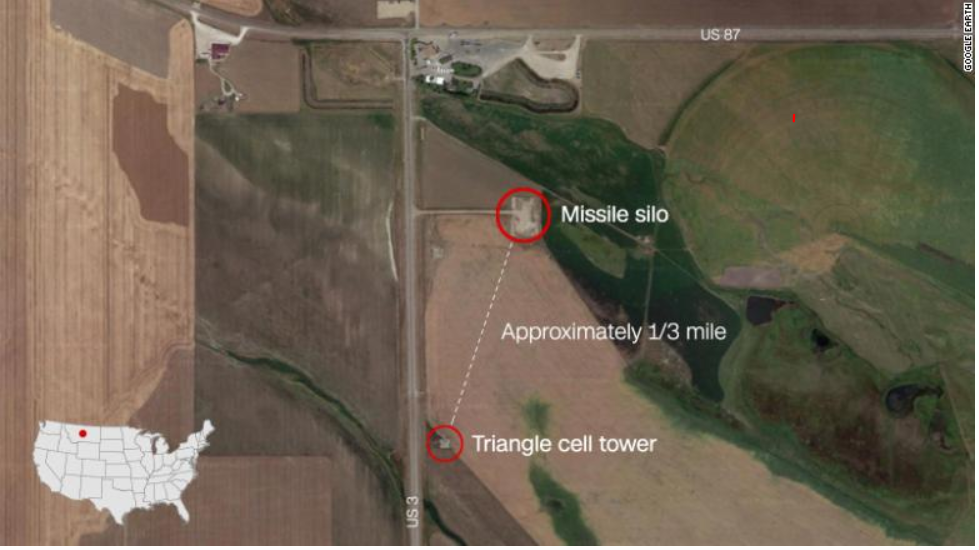
(CNN) – “Outside Malmstrom Air Force Base in central Montana, spread across 13,800 square miles of open plains, more than 100 intercontinental ballistic missiles stand at the ready, buried deep underground in missile silos. These Minuteman III rockets are capable of delivering nuclear warheads at least 6,000 miles away and are part of the U.S. Strategic Command, which oversees the country’s nuclear and missile arsenal.”

Last year CIA, NSA and FBI officials warned in a congressional hearing that Americans, both companies and local governments, should not use products Huawei or ZTE.
FBI Director Wray explained at that time:
There is a risk of letting any company “beholden to foreign governments” inside the country’s telecommunications infrastructure, he said. Huawei is a global leader in networking equipment, and the government has previously blocked it from selling technology to some federal agencies.
“It provides the capacity to maliciously modify or steal information,” Wray said. “And it provides the capacity to conduct undetected espionage.”
Huawei has not made strides in the U.S. market in large part because of government concerns that the Chinese government can use its smartphones and other products for intelligence gathering.
“In 2012, Congress released a report saying the two Chinese companies should be viewed “with suspicion.” The companies both strongly disputed the reports’ findings at the time, with Huawei calling them “baseless.””
On and off for more than a decade Americans have been hearing reports of government officials using “cheaper” Chinese components from cell phones to military planes.
In a 2014 Reuters report, after the discovery that Chinese raw materials were being used in the F-35 fighter jet, an internal Pentagon investigation discovered that “Chinese materials in other major U.S. weaponry, including Boeing Co’s B-1B bomber and certain Lockheed Martin Corp F-16 fighters” were uncovered as well.
New defense intelligence assessment warns China nears critical military milestone; Jan 15, 2019; DefenseNews
In recent years, top defense officials and internal Pentagon reports alike have cautioned about the rise of China as a military power, in large part due to its investments in high-end technologies like hypersonics and its development of indigenous capabilities like stealth fighters and aircraft carriers.
But it’s not a piece of hardware that’s most worrisome for American interests, according to a new assessment by the Defense Intelligence Agency. Instead, it’s the worry that the Chinese service members behind each system have reached a critical point of confidence where they now feel that in combat, the People’s Liberation Army can match competitors.
In the long term, that could be bad news for America — and especially for Taiwan.
Speaking to reporters Tuesday ahead of the new DIA 2019 “China Military Power” report, a senior defense intelligence official called the idea that Beijing might soon trust its military capabilities well enough to invade Taiwan “the most concerning” conclusion from the report.
In other national security news involving China and China’s Huawei Technologies.
A new front has opened in the battle between the U.S. and China over control of global networks that deliver the internet. This one is beneath the ocean.
While the U.S. wages a high-profile campaign to exclude China’s Huawei Technologies Co. from next-generation mobile networks over fears of espionage, the company is embedding itself into undersea cable networks that ferry nearly all of the world’s internet data.
About 380 active submarine cables—bundles of fiber-optic lines that travel oceans on the seabed—carry about 95% of intercontinental voice and data traffic, making them critical for the economies and national security of most countries.
Current and former security officials in the U.S. and allied governments now worry that these cables are increasingly vulnerable to espionage or attack and say the involvement of Huawei potentially enhances China’s capabilities.
Huawei Marine’s Undersea Cable Network
Wall Street Journal
The Chinese company, majority owned by Huawei Technologies, has worked on some 90 projects to build or upgrade submarine cables around the world.
